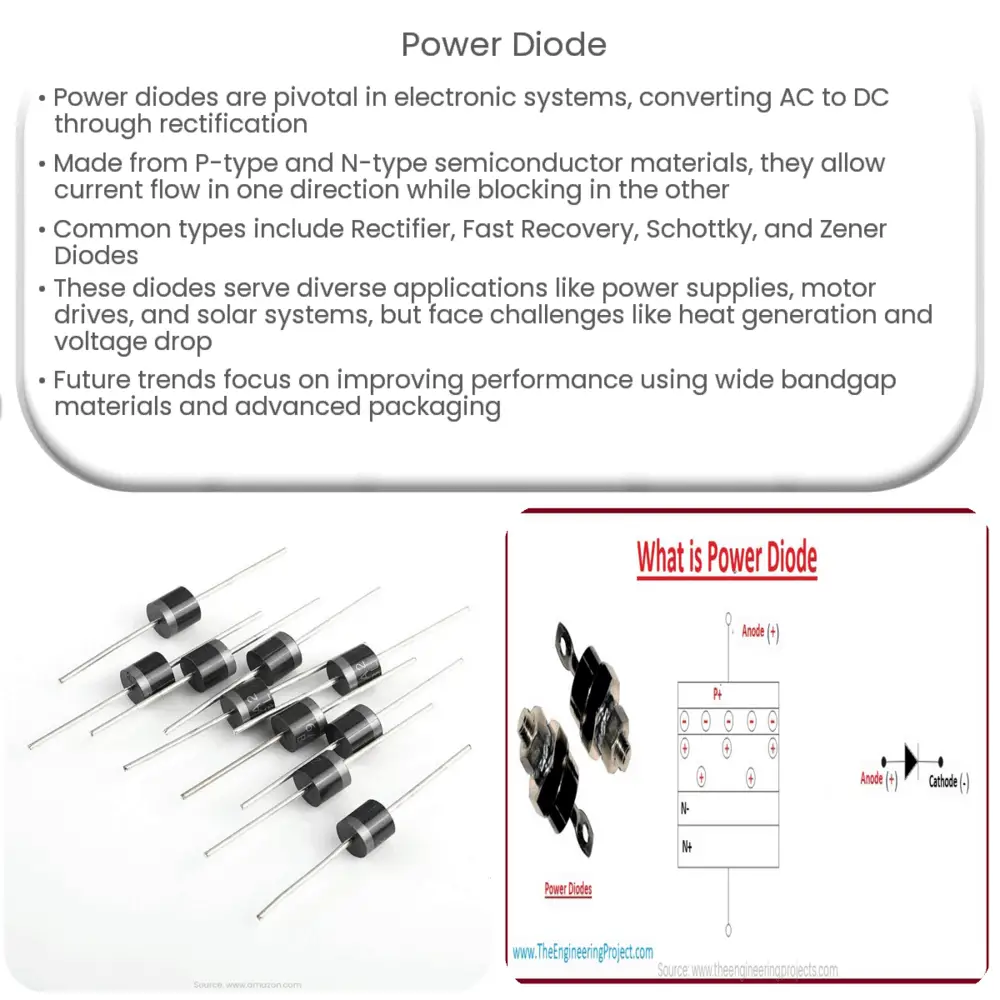A power diode is a semiconductor device that converts AC to DC, handling high voltage and current levels in electronic systems and power applications.

Power Diode: An Overview
Introduction
A power diode is a vital component in electronic systems and power electronics applications, responsible for converting alternating current (AC) to direct current (DC) in a process known as rectification. Power diodes are specifically designed to handle high voltage and current levels in order to accommodate the demands of various electrical devices and circuits. In this article, we will explore the basic principles, types, and applications of power diodes.
Basic Principles of Power Diodes
A diode is a semiconductor device with two terminals, anode and cathode, that allows current to flow in one direction only. It is made from a combination of P-type and N-type semiconductor materials, which create a PN junction. When a positive voltage is applied to the anode and a negative voltage to the cathode, the diode is in a forward-biased state, allowing current to flow through it. Conversely, when a negative voltage is applied to the anode and a positive voltage to the cathode, the diode is in a reverse-biased state, preventing current flow. The power diode’s primary function is to allow the flow of current in one direction while blocking it in the other.
Types of Power Diodes
There are several types of power diodes, each designed to cater to specific requirements and applications. Some of the most common types include:
- Rectifier Diodes: These are the most basic type of power diodes, used primarily for rectification purposes in power supplies and other applications requiring the conversion of AC to DC.
- Fast Recovery Diodes: These diodes are designed to switch between conducting and non-conducting states more rapidly than standard rectifier diodes. They are commonly used in high-frequency applications, such as switch-mode power supplies and inverters.
- Schottky Diodes: Schottky diodes are known for their low forward voltage drop and fast switching speeds. They are often used in high-frequency applications, voltage clamping, and as rectifiers in low voltage, high current power supplies.
- Zener Diodes: Zener diodes are designed to operate in the reverse-biased state, where they maintain a constant voltage across their terminals. They are commonly used for voltage regulation, overvoltage protection, and as reference elements in various electronic circuits.
Applications of Power Diodes
Power diodes are used in a wide range of applications due to their ability to handle high voltage and current levels. Some of the key applications include:
- Power supplies: Power diodes are an essential component in converting AC to DC in power supply units, chargers, and adapters.
- Motor drives: Power diodes are used in motor drives to provide protection against reverse voltage and to enable smooth and efficient operation of motors.
- Solar power systems: Power diodes are used in solar power systems to prevent reverse current flow from the batteries to the solar panels during nighttime or low light conditions.
Benefits of Power Diodes
Power diodes offer several advantages in various electronic and power applications, including:
- Efficiency: Power diodes effectively convert AC to DC with minimal power loss, contributing to the overall efficiency of electronic systems.
- Reliability: Due to their simple construction and low component count, power diodes have a long operational life and high reliability.
- Compactness: Power diodes are available in various sizes and form factors, making them suitable for space-constrained applications.
- Cost-effectiveness: Power diodes are relatively inexpensive compared to other electronic components, making them an attractive choice for cost-sensitive applications.
Challenges and Limitations
While power diodes offer numerous benefits, they also have some limitations:
- Heat generation: Power diodes generate heat due to their inherent power dissipation, which may necessitate additional cooling mechanisms in high-power applications.
- Reverse recovery time: Conventional power diodes exhibit a delay in switching from conducting to non-conducting states, known as reverse recovery time. This delay can lead to power losses and reduced efficiency in high-frequency applications.
- Voltage drop: Power diodes exhibit a forward voltage drop when conducting current, which results in power losses and reduced efficiency.
Future Trends and Developments
As the demand for efficient and reliable power electronics continues to grow, researchers and manufacturers are working on improving power diode performance and addressing their limitations. Some of the key areas of focus include:
- Wide bandgap materials: The use of wide bandgap materials, such as silicon carbide (SiC) and gallium nitride (GaN), has shown promise in improving power diode performance by reducing switching losses, increasing operating temperatures, and enabling faster switching speeds.
- Advanced packaging: New packaging technologies are being developed to enhance thermal management and reduce the size and weight of power diodes, making them suitable for more demanding applications.
- Integration with other components: The integration of power diodes with other power electronic components, such as transistors and controllers, is expected to simplify system design and improve overall efficiency.
Conclusion
Power diodes are essential components in the field of power electronics, providing efficient and reliable rectification in various applications. With ongoing research and advancements in materials and technologies, the performance of power diodes is expected to improve, enabling them to meet the growing demands of modern electronic systems and emerging applications. Understanding the principles, types, and applications of power diodes is crucial for engineers, technicians, and hobbyists working in the field of electronics and power systems.

